In this post, we go over all you need to know about when and how much to feed your dog or puppy.
In general, deciding how much to feed your dog or puppy per day depends on several factors such as your dog’s age, activity level and the type of food you feed him.
Below, we’ve made an outline of all the topics covered in this post. Feel free to click on any of the links to jump ahead to the section most helpful to your situation.
In the comments, let us know if you have any questions or feedback!
IN THIS POST:
- How much should you feed your dog per day?
- Dog feeding calculator by weight
- How often should you feed a puppy?
- What time of day is best to feed a dog?
- How to get a dog on a feeding schedule
- Should you feed your dog before a walk? Or after?
- Is it Ok to feed my dog once per day?
- How to feed your dog a healthier diet
How much should you feed your dog per day?
The first tip we’d like to share is to measure out your dog’s meals until you’ve determined how much food he needs on a daily basis, regardless of what type of food you feed.
Eyeballing it can quickly result in too much food in your dog’s bowl, but it could also mean that your dog might not be getting enough food.
The following guidelines are roughly what adult dogs of different weight categories should be fed in dry food every day:
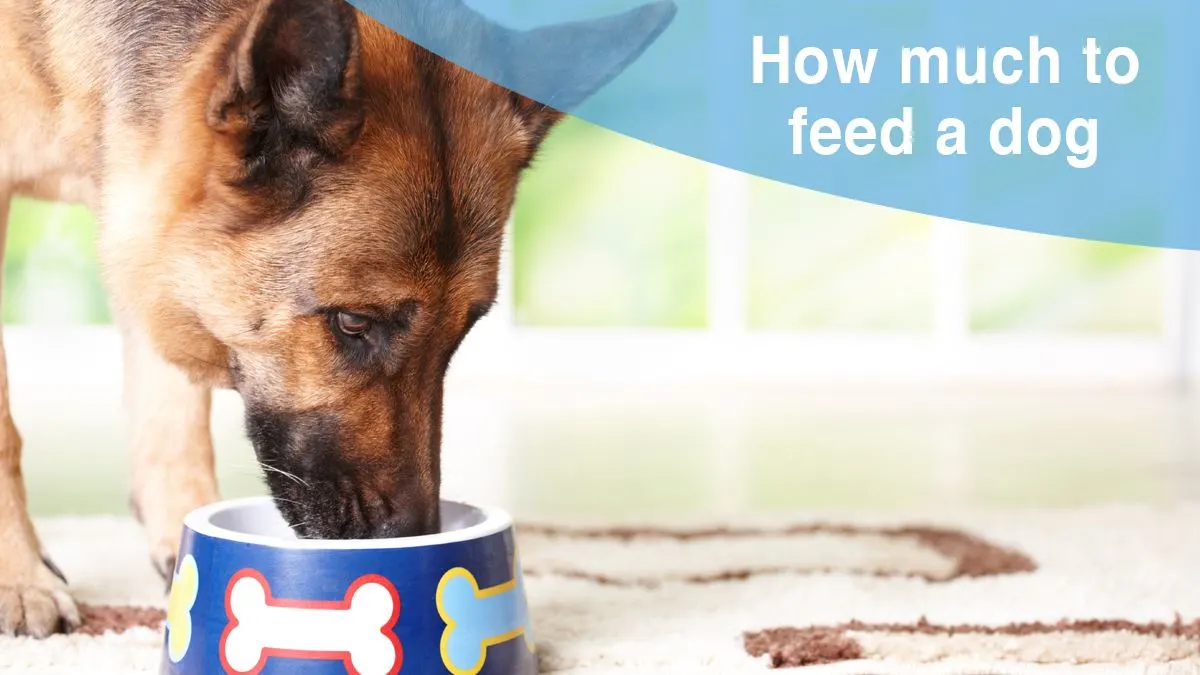
In general, figuring out exactly how much you should feed your dog per day depends on these five factors:
1. Is your dog overweight, underweight, or at his target body weight?
You’ll want to adjust his daily food intake accordingly. Decrease your dog’s daily food allowance if he’s overweight, and don’t forget to factor in treats you feed your dog as well. Treats have calories and do count towards your dog’s daily caloric requirements. A dog who’s overweight has a sagging belly, no visible waistline, and tires easily.
Increase your dog’s daily food allowance if he’s underweight. A dog who’s (severely) underweight has protruding ribs, hips, and backbones, and also tires easily as his daily caloric requirement that gives him energy isn’t met.
If your dog is at his target body weight, keep feeding him the amount of food you’ve been feeding him on a daily basis. A healthy dog who’s at his target body weight has a visible waistline, no sagging belly, and a decent amount of energy.
We recommend working with your vet if your dog is severely under-or overweight.
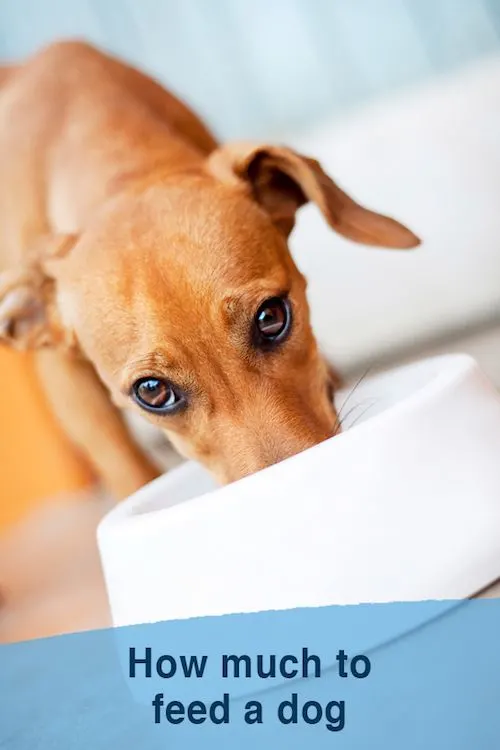
2. How active is your dog?
Is your dog a couch potato, moderately active, active, or even a super active working dog who’s on his feet the majority of the day?
Again, you’ll want to adjust your dog’s daily food intake according to how active or inactive he is. You can start with small adjustments to his current food intake and work your way up to his ideal amount of food.
3. Is your dog pregnant or lactating?
Pregnant and lactating dogs need considerably more food than their non-pregnant/lactating counterparts. They need up to 3 times the amount of food they’re usually fed.
4. How old is your dog?
Your dog’s age plays an important factor in determining how much food he’ll need on a daily basis. Puppies need a lot more food than adult dogs, and senior dogs need less than adult dogs as they slow down.
5. What kind of food are you feeding your dog?
The very food you’re feeding your dog will also contribute to the amount needed per day. Dry dog food tends to contain a lot of fillers that aren’t very rich in nutrients, making it necessary to feed more than you would need to feed a dog on a raw diet.
Always check in with your traditional or holistic vet if you’re unsure of your dog’s body condition and would like their advice on how much food to feed.
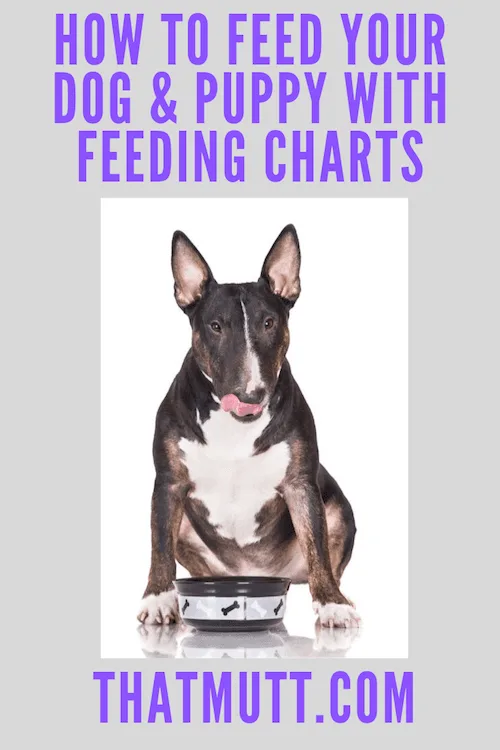
Dog feeding calculator by weight
All commercially available dog food includes printed instructions on how much of the food dogs should be fed on a daily basis. This applies to bags of dry dog food, containers and pouches of wet dog food, as well as to chubs and bags of pre-made raw dog food.
Although these instructions are categorized by the dog’s weight, they should only be considered general feeding guidelines.
That’s because every dog is different and will require varying amounts of food depending on his age, breed, activity level, and metabolism.
A 50 lb active, adult Dalmatian is likely going to require more food than a 50 lb adult English Bulldog who lounges on the couch most of the day.
A pregnant dog will also require much more food on a daily basis than when she isn’t pregnant or feeding her newborns. And senior dogs will likely need less food as their activity levels slow down.
Dog feeding chart – what to feed per day
- Dogs up to 10 lb: ¼ cup to ¾ cup
- Between 10-25 lb: ¾ cup to 1 cup
- Between 25-50 lb: 1-3 cups
- 50-75 lb: 3-4 cups
- 75-100 lb: 4-5 cups or more
If you feed your dog a raw diet, the general rule of thumb is to feed an adult dog 2-3% of their target body weight per day.
See our article How Much Raw Food To Feed A Dog Per Day? to get a better understanding of how to figure out how much raw dog food your dog needs on a daily basis.
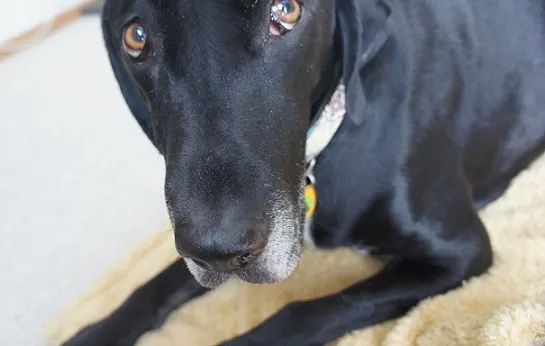
You’ll have to assess your dog’s body condition on a regular basis to determine whether or not you’re feeding him enough or too much food. Your dog should have a visible waistline, and you should be able to feel his ribs easily by running your hands down his side.
If you suspect that he’s overweight, cut back on his food intake and/or feed a leaner protein source and increase his exercise. If you’re unsure about his looks, don’t hesitate to ask your vet for advice. Also see our section later in this post on tips to feed your dog a healthier diet.
How often should you feed a puppy?
Puppies need to be fed several meals per day while they’re growing because their nutritional needs are higher during their growth period, and their stomachs are still too small to hold larger amounts of food. This applies to any type of food, regardless of whether they’re fed dry, wet, or raw dog food.
See this post for more info on feeding a puppy a raw diet.
If you got your puppy from a breeder, ask them what type of food they’ve been feeding the puppy. You don’t necessarily have to continue feeding it, but it’s good to have at least a little of it on hand if you plan on transitioning him to a different food. Allow 7-10 days of transitioning time where you gradually introduce the new food you want to feed and slowly fade out the old food.
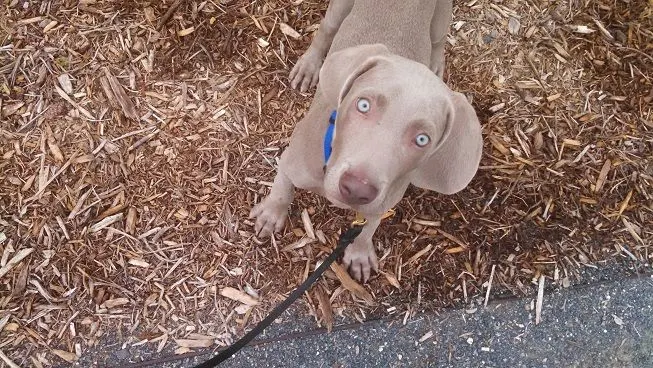
Puppy feeding schedule
How often to feed an 8 week old puppy
Puppies typically require 3 or 4 meals spread out throughout the day after they’ve been weaned from their mother and until they’re at least four months. Lindsay found that this helped her weimaraner puppy Remy be better behaved (since he wasn’t so hungry all the time)!
A puppy’s food can be served in roughly 4 hour intervals, so their feeding schedule could look something like 7 am, 11 am, 3 pm, and 7 pm. If you work or can’t do four meals each day, than three meals a day is fine.
How often to feed a 4 month old puppy
We recommend all puppies switch to 3 meals per day between 4 and 6 months old. These meals could be fed around 7 am, 12 pm, and 5 pm. Once they’re 6 months old, it’s typically ok to offer only 2 daily meals for breakfast and dinner, around 7 am and 7 pm or whatever works with your schedule.
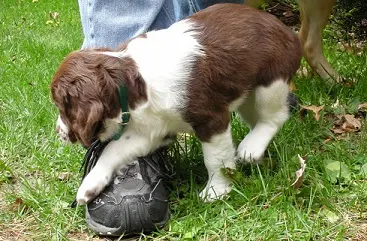
Obviously, you’ll have to adjust feeding times a little depending on what your personal schedule looks like. These recommendations were just general guidelines.
We do recommend feeding your puppy on a somewhat regular schedule each day to help get him potty trained. It’s also a good idea to feed his last meal of the day about 2 hours before bedtime. That way, he’ll have enough time to eliminate before you’ll tuck him in for the night!
See our post: Puppy potty training.
Puppies have to go potty within about 30-45 minutes of mealtime, so you’ll want to add that time into your schedule while housetraining him. Some people decide to only feed their dogs once per day when the dogs have turned 1 year old. See our section later in this post, Is it OK to feed my dog once per day? for more information on this option.
What time of day is best to feed a dog?
Generally speaking, it’s best to schedule meals for your dog and feed him twice a day. Figure out how much food he needs on a daily basis and split that amount up into two servings – one for breakfast, one for dinner.
In our opinion, the benefits of scheduled meals far outweigh the convenience factor of “free feeding.”
Benefits of a feeding schedule for dogs
- Weight control. Free feeding contributes to obesity, and unfortunately more than 50% of all American dogs are fat! Did you know that obesity also contributes to heart disease, diabetes, pancreatitis, arthritis, and respiratory problems?
- Food won’t spoil. The oils in kibble get rancid when they’re exposed to oxygen for an extended amount of time.
- Food won’t attract pests. Who cares for ants, roaches, or flies in their homes?!
- Something for your dog to look forward to/work for. Food can be a wonderful reward for having obeyed obedience commands on a walk or after a completed session of doggie sports! A dog who has constant access to food is also less likely to be interested in performing tricks in exchange for food.
- Potty training. It will be considerably more challenging to potty train puppies who are free-fed because their elimination schedule will be harder to predict. The same applies to older dogs who aren’t properly house trained.
That being said, it will also depend on your dog’s age as well as your personal schedule when making the decision of when to feed him. If your dog is still a puppy, he’s going to need several meals throughout the day. (See our previous section How often should you feed a puppy?).
Should you have a crazy busy day and know you won’t be home in time for your adult dog’s second scheduled meal, you could technically give him a larger meal when you leave your home in the morning.
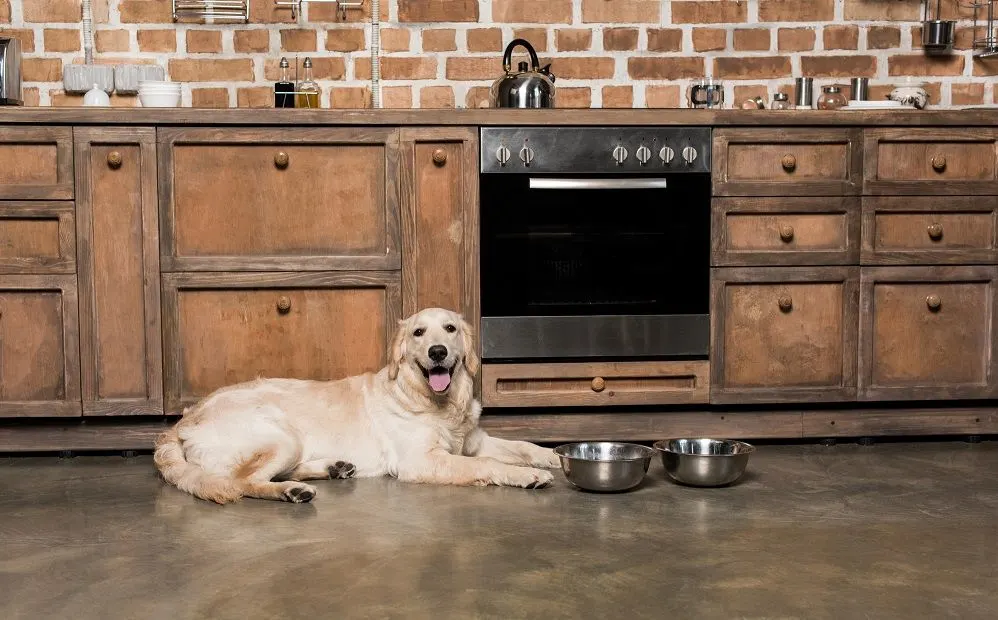
This should, however, only be the exception. We don’t recommend doing this for larger chested dogs out of concern for bloat (more on that in our section Should you feed your dog before a walk? Or after?), and it would also be a very long time to leave your dog alone.
A better option would be to have someone from your support system check in on your dog, give him a potty break, as well as feed him the second meal.
Your support system could consist of family members, friends, neighbors, or fellow church goers. See if you can barter pet care or return the favor with offering babysitting. Another option would be to hire a professional dog walker/pet sitter.
How to get a dog on a feeding schedule
Dogs are creatures of habit, just like us humans. If a dog has been free fed, i.e. has had access to food 24/7, it can take a little time to retrain him to eat at specific times of the day only.
Try offering your dog his daily food allowance split up into two to three meals spread out throughout the day. Set down his breakfast bowl and give him 10 minutes to eat. It’s likely that he either won’t touch it at all or that he’ll only take a few bites.
After all, he was used to having food available at all times and never had to finish his food within a certain amount of time.
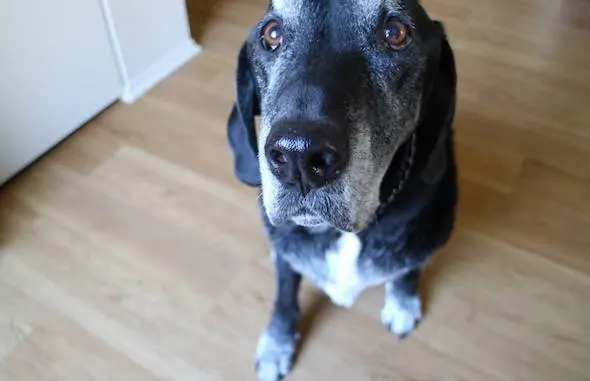
After 10 minutes, pick the bowl back up and offer it to your dog again at lunchtime or dinner, depending on how many meals you plan on offering him. Give him another 10 minutes to eat, then pick the bowl back up. He may not get the new routine on day one, but he should adjust to his scheduled mealtime within a few days.
One way to increase his appetite is to exercise him before offering him any meals. Try taking your pup for a walk or have some playtime with him prior to feeding him.
If he’s generally not very food motivated, try switching his brand or mixing some healthy, tasty food toppers in with his current food.
You could try mixing in some of the following:
- Bone broth or unsalted regular broth
- Warmed up coconut oil
- A raw egg
- Finely chopped up or pureed non-starchy veggies like broccoli, cauliflower, red pepper, and shiitake mushrooms (dogs can’t break down plant cell walls, so for optimal nutrient absorption we need to do that for them)
- Alternatively, try the store bought supplement Green JuJu (available at most independently owned pet food retailers who sell raw dog food)
- Blueberries, blackberries, strawberries, or raspberries
In our opinion, a balanced raw dog food diet is the healthiest food option for most dogs (& cats!), and our dogs love their raw dog food. We never have to wait very long for their bowls to be licked 100% clean, so it goes without saying that our pups aren’t free-fed!
If you’re interested in learning more about raw dog food, check out the following articles:
Now, let’s reiterate the benefits of scheduled meals:
- Weight control, especially in multi-pet homes. You’ll know exactly who eats how much food.
- Pest control. Pet food that sits out at room temperature can attract ants, roaches and flies.
- Regular poop schedule. Your dog will be on a fairly consistent poop schedule once he starts eating at specific times of the day.
- Avoiding nutrient loss. Dry pet food that comes into contact with air for an extended period of time loses its freshness and the food starts to spoil.
Excerpt from Steve Brown, Unlocking the Canine Ancestral Diet, page 88:
When dry dog foods absorb moisture from the surrounding air, the antimicrobials used by manufacturers to delay mold growth can be overwhelmed, and mold can grow. The molds that consume dry pet foods include the Aspergillus flavus mold, which produces Aflatoxin B1, the most potent naturally occurring carcinogenic substance known.
And now, a bit about exercise …
Should you feed your dog before a walk? Or After?
It’s generally best to feed your dog after you have taken him for a walk. Just like us humans typically don’t exercise on a full stomach, the same concept applies to our four legged friends.
Taking your dog for a walk right after he’s eaten (or had large amounts of water) increases the risk of a condition known as bloat tremendously.
Bloat is also known as Gastric Dilation Volvolus. It’s an acute, life threatening condition where the stomach traps air or fluid, turns on itself and closes off the esophagus, meaning vomiting will no longer be possible and the blood supply to vital organs gets cut off.
Bloat requires immediate medical attention, so it’s important to be familiar with the symptoms of bloat:
- Retching
- Panting
- Salivating
- Pacing
- Enlarged belly
Bloat is particularly common in large chested dogs like great danes, boxers, dobermans, weimaraners, German shepherds, setters, Saint Bernards, basset hounds, akitas, standard poodles and Newfoundlands, but technically any dog can get bloat.
So ideally, you’ll want to take your dog for a walk or exercise him before offering him a meal.
If that’s not possible, wait at least one hour (2 hours is better) before you exercise him or allow playtime once you’ve fed him. If your dog is young and energetic, you may want to crate him after his meal if he wasn’t exercised prior to being fed to ensure he won’t race around with a full belly.
Barbara has been starting her days with doggie backpack walks since 2012, when her then Boxer pups Missy & Buzz were old enough to carry the weight of a dog backpack. After the walk, it was mealtime for the pups!
See our post: Benefits of a dog backpack
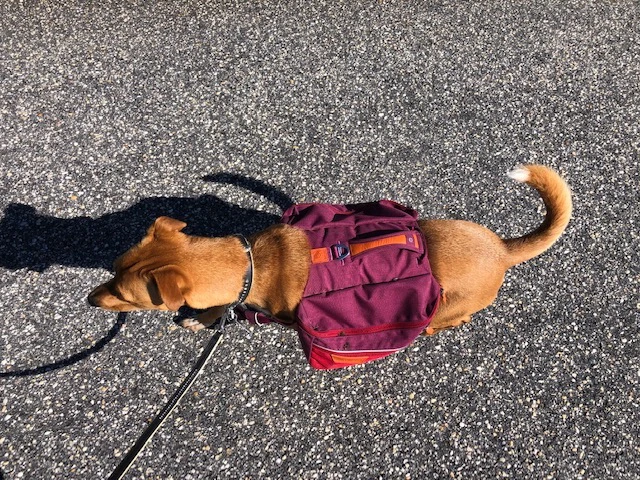
Barbara’s current dog, Wally
The benefit of starting your day with a walk followed by a meal is that you’ll be draining your dog of his energy levels he replenished while sleeping at night.
You’re also making him work for his food, and a well exercised dog won’t feel the urge to race around after having eaten. On the contrary, he’ll instinctively look for a comfy place to nap.
We also recommend to have your dog eat his meals slowly as this will decrease the likelihood of bloat occurring, especially if he has a deeper chest.
You could try serving the food in a slow feeder bowl or in a food puzzle like a hollow KONG or Nylabone dog toy, especially if your dog is known to inhale his food.
Another option to slow him down is by having him take breaks during mealtime. You could ask him to “wait” or “leave it” every 2-3 seconds.
Is it OK to feed my dog once per day?
We don’t necessarily recommend feeding your dog once a day, and it’s not a good idea for puppies, extremely active dogs or dogs that have trouble keeping their weight up.
Most people tend to feed their dogs twice a day, a morning and an evening meal and that schedule seems to work out well for most dogs.
However, if you want to feed your dog once large meal per day, it is certainly possible and many dogs will adapt to this schedule. If you’re not sure if this is best for your particular dog, you should discuss with your dog’s vet to be sure.
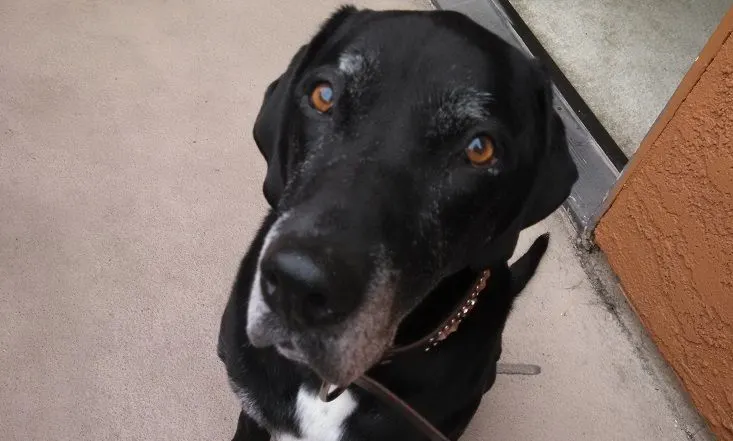
Reasons to feed a dog once per day
- Convenience
- Decrease stress or conflicts between dogs at meal times
- More “natural” way a carnivore would eat in the wild
- Potential health benefits of “intermittent fasting” for dogs
Convenience & decrease stress
Lindsay tried feeding her dog Ace and her two cats once per day a couple of years ago. She started this as a trial to see how they would do and how they would adjust to the schedule.
You see, feeding time was very stressful for everyone in the family because kitty Beamer was extremely obsessed with food! Like most pets, he knew exactly when feeding time was and he would begin meowing, scratching, pacing, sprinting around the room and knocking things over about two hours before each meal! He would also lash out at the other pets in his frustration by scratching and hissing at them.
In addition to Beamer’s begging, Lindsay’s other cat Scout was having some issues where he was not using the litter box. Feeding Scout once per day seemed like a better way to predict and control his “schedule.”
So yes, this started out because of the cats but she decided to switch her dog over to one meal per day as well. They received this meal in the morning, and it did make life less stressful. After a few days, the animals didn’t seem to mind and they adapted to this once a day feeding schedule.
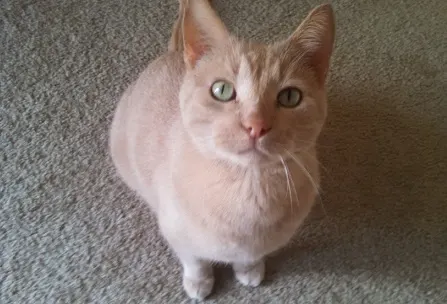
Lindsay assumed the animals would “protest” this new schedule and beg like crazy for their usual second meal around 5 p.m. Instead, they only begged for a couple of days and then they stopped begging because the 5 p.m. meal was no longer part of their routine.
In other words, they would beg because they knew there was a meal coming as part of their schedule, not because they were necessarily hungry.
A more natural way for a carnivore to eat
It’s usually feast or famine for gray wolves, according to the International Wolf Center, an organization that provides information on wolf biology. Finding food is a full-time job for them, so they have to be able to go days or even weeks without eating much. When they do catch a large mammal, boy do they eat! An adult gray wolf is able to eat up to 22 pound of food at one time!
Many of the dogs we’ve cared for actually choose to eat once a day or even once every two days! They eat a large quantity of food at one time and then they are good to go for a few days.
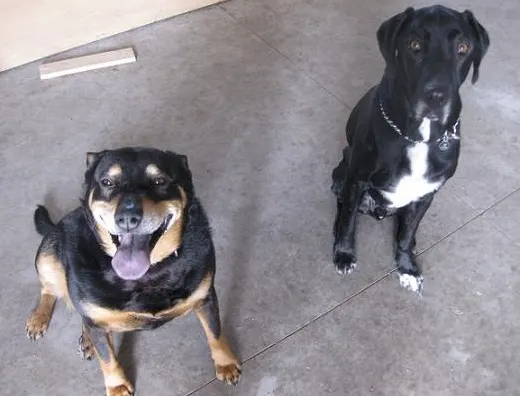
We believe that part of the reason they eat this way when we care for them is because their routines are off. Their usual “triggers” such as their owners coming home from work do not occur so they eat when they are naturally hungry.
Another factor to keep in mind is that most dogs would love to be out exercising for most of the day just like wolves.
Most dogs would prefer to work for and earn their food. We’re not saying this is always convenient for the humans. It’s just something to consider. After all, most of us would prefer to work for and earn what we own rather than have everything handed to us.
Will my dog throw up if he eats one large meal?
He might 🙂
Lindsay’s dog Ace was one of those big-chested dogs with a small waist. She always had Ace lie down even after drinking water or he would throw up!
As we mentioned earlier, bloat is a potential issue as well. So when Ace ate a large meal, Lindsay keep him quiet for an hour or so afterwards. He was fine to go for a walk, but she didn’t throw his ball or take him running until a few hours later. He naturally wanted to curl up for a nap after he ate anyway.
How should I switch my dog to one meal per day?
Just switch him, cold turkey. It’s no big deal. Just combine his meals to one so he gets one larger meal. If he doesn’t eat all the food, then put it away after 10 minutes. He’ll be hungry the next day.
Feed him at the same time every day to help him get used to the new routine. Don’t feel bad for him. He’ll adjust to the new routine after a few weeks.
I’m not saying it’s better to feed a dog once per day. It just works for some. If you want to feed your dog two or three meals per day, then by all means, go for it.
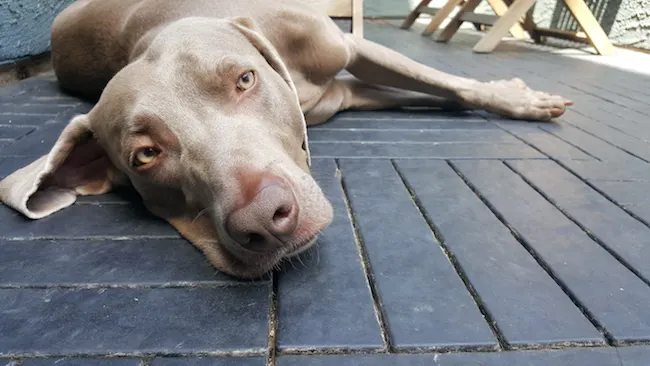
How to feed your dog a healthier diet
There’s a lot of pressure on dog owners to feed their dogs a healthy, natural diet, but what does that even mean?
For us, feeding our dogs a healthy, natural diet means to feed them the healthiest food we can afford.
We (Lindsay and Barbara) both feed our dogs a raw diet. Here are our tips for adding healthier food to your own pup’s meals.
5 tips for adding healthier food to your dog’s diet
1. Mix your dog’s current food with a healthier food.
If you’re struggling to afford that standard bag of dry dog food, don’t feel guilty. Most dogs can get by just find on less-expensive dry food just as we can get by on boxed dinners.
What you could do is buy a bag of higher-quality dry food when you can, and mix just a little with your dog’s regular food for each meal. For example, maybe 25 percent of the meal is the new food. That way, your dog gets some of the healthier food, and you don’t have to spend too much.
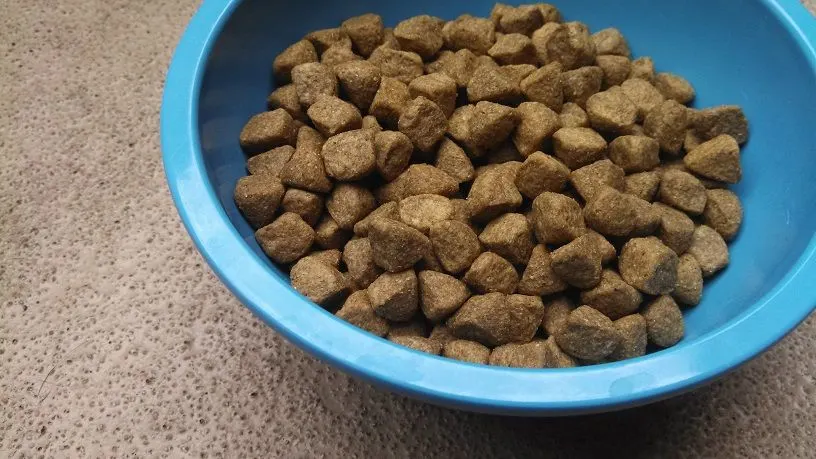
Adding just a small amount of higher-quality food vs. a full meal will also be easier on your dog’s tummy since some dogs are sensitive to change.
There’s a lot that goes into determining a higher-quality dry food, but a quick way to get an idea is to take a look at the actual ingredients. A higher-quality food will list real, specific protein sources as the top ingredients such as chicken, duck or turkey. It may also include fruits and veggies. And while it might include some grains such as brown rice, it will not include corn.
2. Add some high-quality canned food.
Canned food can also get expensive, but you could buy just a few cans and add a few spoonfuls to each of your dog’s meals a few times per week. I recommend the highest-quality canned food you can afford. Again, to determine the quality, read the label and look for a canned food with real protein and without corn, soy or wheat.
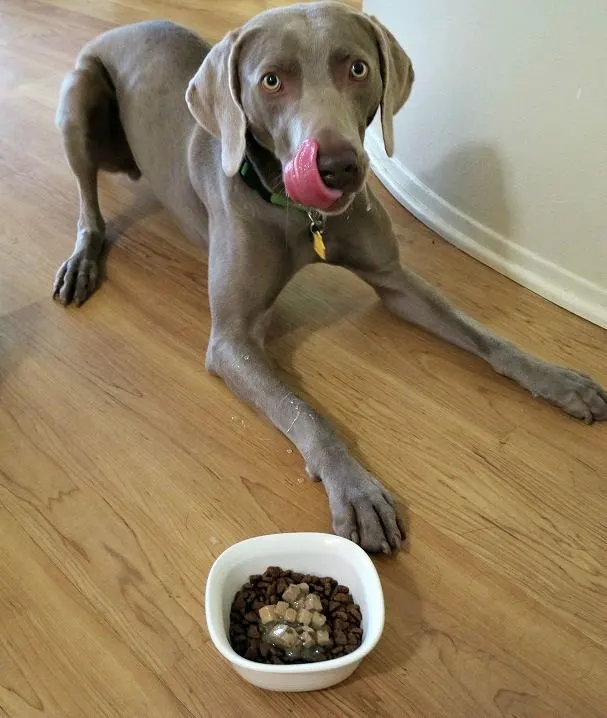
3. Add healthy “table scraps.”
You probably don’t want to encourage your dog to beg, so don’t feed him right from the table if that’s the case.
However, once you’re done eating, set aside some small pieces of healthy meats and veggies for your dog, and then put the food in his bowl. Some examples could include pieces of chicken, steak, carrots, spinach, eggs or green beans.
Don’t feed your dog cooked bones. These can be choking hazards and can also be dangerously sharp. Also, make sure you know which foods are not healthy to dogs such as onions. I also wouldn’t feed food that is high in sodium, because too much sodium can give some dogs an upset tummy.
Introduce new foods slowly and only one at a time. Eventually you’ll know what your dog can handle. For example, my dog Ace never seems to get an upset tummy when I add table scraps to his food, probably because his digestive system is used to a variety of cooked and raw foods.
4. Rotate your dog’s food to a different protein source.
I believe most dogs benefit from variety in their diets, unless they have allergies or other health issues that require them to remain on a strict diet.
If you can’t afford a high-quality food for your dog, you can still rotate between the different varieties of the brand you’re currently feeding. For example, feed the chicken variety one month, lamb the next month and beef the next. If your dog has a sensitive tummy, make each switch very gradual by mixing them over a week or so.
5. Feed one raw meal per week.
Raw food is the healthiest diet for most dogs, but it’s also more expensive unless you want to make your own raw dog food recipes. If you’re interested in feeding your dog raw, one way to get started is to feed your dog one raw meal per week or even every other week.
You could either buy a bag of commercial raw food and keep it in your freezer, or you could make your dog’s raw meals yourself using raw meat, bones and organs. You also don’t have to worry so much about “balance” if you’re just feeding one raw meal per week.
Now we’d love to hear from you!
In the comments, let us know how often you feed your dog per day and why!
Barbara Rivers writes regularly for That Mutt. She is a blogger, raw feeder and dog walker and maintains the blog K9s Over Coffee.
Lindsay Stordahl is the founder of That Mutt. She writes about dog training and behavior, healthy raw food for pets and running with dogs.


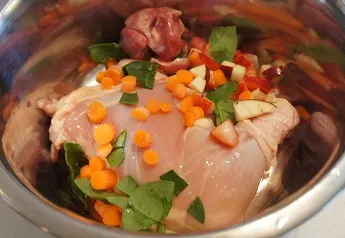
Lisa Adcox
Wednesday 21st of June 2017
I switched to once a day a few months ago.Mine are eating better than ever. They didn't eat well at second time before so we tried the once a day feeding.Huge success. They look good, have not lost or gained weight. They get snacks once a day. That is early mornings after first outing of the day
Lola
Tuesday 12th of July 2016
When I newly adopted my underweight dog,he was fed twice a day and loved it . Feeling plentiful in his new home .Two months later he had a growth spurt needing more food! Then he seemed to be getting cubby so I reduced his meals. Now 8mos later he doesn't want two meals n prefers only one meal a day. If he chooses not to eat. Because it wasn't delicious enough. I don't mind. Dogs can go a few days without food some people intentionally skip a day thinking it's better for the digestion
Brianna Grizzelle
Sunday 7th of September 2014
I feed my chihuahua minipin mix once a day. Asa puppy she ate three times a day. Then around seven months she ate twice a day. She's now ten months and only eats once a day. She switched to once a day all on her own. Sometikes she goes two or three days without eating and she's perfectly healthy!!
Denise
Monday 4th of March 2013
Cold turkey? that is CRUEL? Are you KIDDING? Talk to your vet. If you are feeding your pet twice per day and all of the sudden shift..that is CRUEL and just go ahead and find a dear friend who will LOVE your pet as a family member. My goodness : shifting a pet's food ..one should slowly introduce the new food....tha's from a Vet...and now you are saying I'm used to breakfast and dinner and you're just going to STARVE me for one meal - that's what it is. that is cruelty. WE as humans have DOMESTICATED pets - comparihng them to the wild is NUTS and INGNORANT - so PLEASE - talk to your vet and someone who understands pets and IS NOT TRYING TO JUST ACCOMODATE A PET TO THEIR STYLE FOR THEIR OWN SAKE. pets are a gift from God - and if we have the blessing of their love - let's return it - not abuse it.
Vijay
Thursday 27th of April 2017
Kindly shut up ,,,, nothing will happen if u switch them to one meal all of a sudden,,,and no vet's bullshit opinion is needed. Some expert u are.
Linda
Wednesday 27th of February 2013
I have two smaller dogs. One is on a hepatic diet, and one has a sensitive stomach. I have found that i can feed them their respective canned food once a day. I can leave a small amount of dry dog food out all day. They much prefer the moist food and only eat the dry if they're hungry, which isn't often. Maybe once or twice a week. Neither is overweight. They are both active.